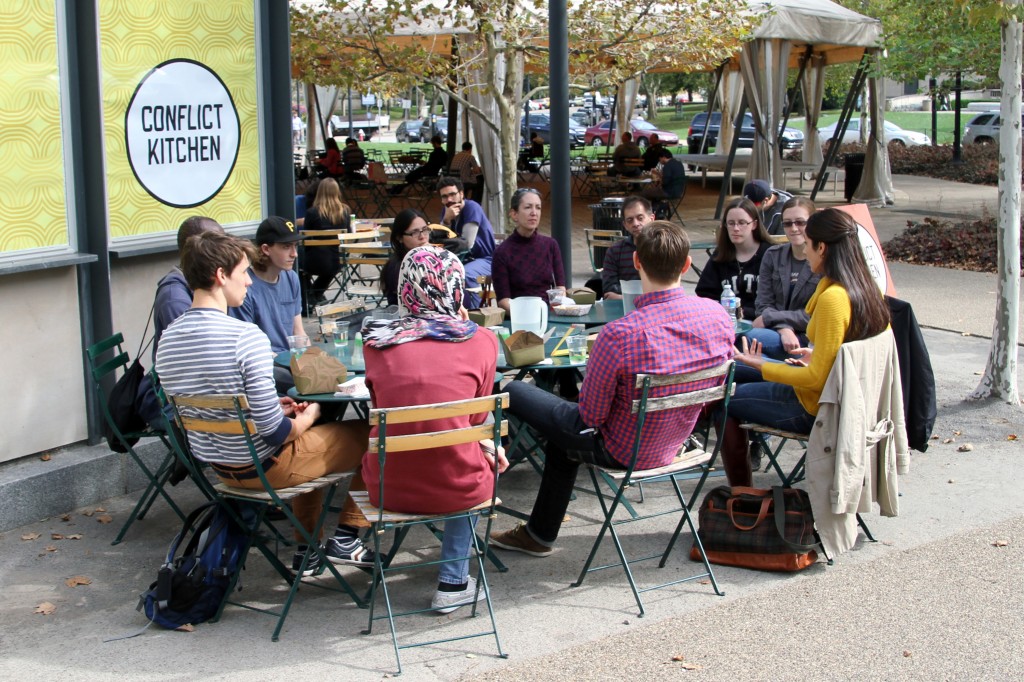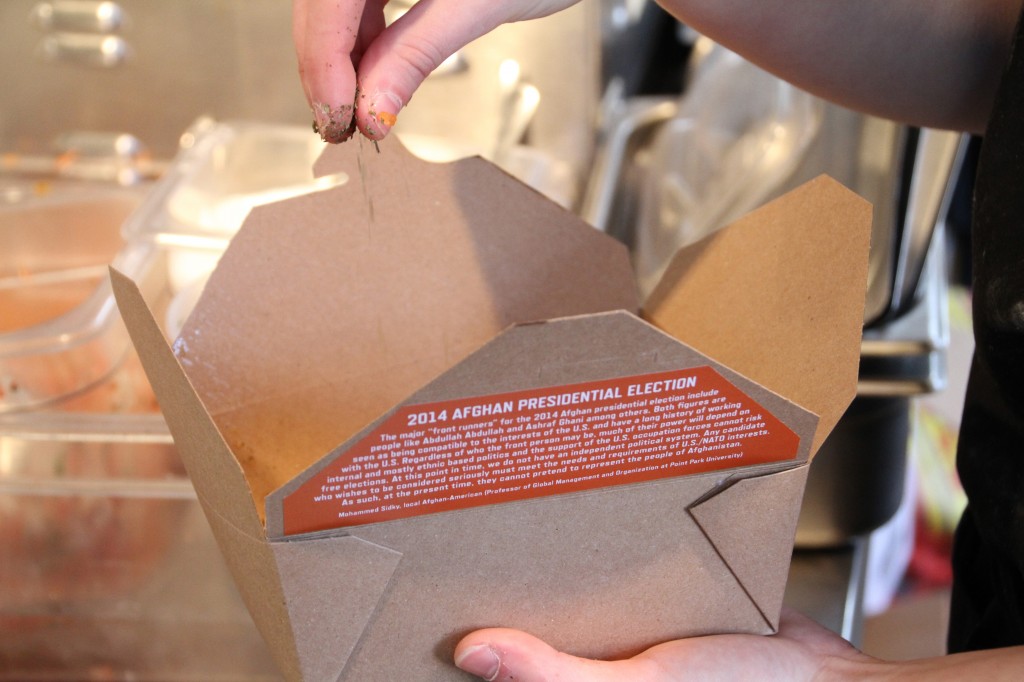Public Spaces and Agonistic Pluralism in Political Design: The Case of "Conflict Kitchen"
Posted on December 20, 2014In the article “Design Democracy and Agonistic Pluralism”, Carl DiSalvo presents an alternative approach to the consensual ideal of democracy. Some of his ideas resonate with our last discussion held around agonistic public and the importance of deliberative process. For DiSalvo, agonistic pluralism is a model of democracy grounded in conflict. This productive contest as he calls it takes place through all forms of social practices. Drawing from political theorist Chantal Mouffe’s ideas, he address to the designers’ community:
One of the tasks of those wishing to support and further democracy is, then creating and enabling these spaces of contest. In such spaces difference and dissensus are brought forward and the assumptions and actions that shape power relations and influences are revealed and challenged. (2)
These ideas are linked to the notion of public sphere presented by Maria Hellström Reimer. According to her, liberal democracy needs a space or spaces for public assembly, deliberation or even confrontation, which have to be different from other spaces where power relations are institutionalized and aren’t questioned such as the state and the market. Although they are not taken as essential, rational deliberation and consensus (main features of consensual democracy) are possible in these spaces. The question that surfaces is then: If as Hellström points out: “when something is materialized, it has life on its own and established configuration”; how to enable multiples reconfigurations within it? In other words, how design can provide these open spaces for agonistic pluralism?
Further in his analysis DiSalvo gives a clue. He presents a distinction between politics and the political, which I think could be related to Maria Hellström Reimer´s notions of materiality, public sphere, Öffentlichkeit, and the possibility of creating these kinds of spaces through design. He states:
In the discourses of agonistic pluralism, politics are the means by which a state, organization or other social order is held together, politics are the structure and mechanism that enable governing. (…) Different from these means, the political is a condition of society. It is a condition of ongoing opposition and contest. (2-3)
Politics range from codified laws and procedures to unspoken but observed habits of interpersonal interaction and performances of beliefs and values; therefore designs have politics. On the other hand, the political is a condition experienced and presented in many ways, from debate to acts of provocation, protest and resistance. (2-3) Materialization always implies a configuration and hence politics understood as structures, however a structure can be design to enable further reconfiguration or the political. In that sense, through their politics, designs provide spaces for the confrontation of opposed narratives; they allow the political. In the following section, I will explain this relation with an example.
Conflict Kitchen: Politics that allow the Political
Conflict Kitchen, a design project by designer and artist Jon Rubin and architect Dawn Weleski aims to use the social relationship of food and economic exchange to engage the general public in discussion about countries, cultures and the polarizing rhetoric of governmental politics. Located in Pittsburgh, it seeks to challenge the narrowness of media approach to these issues and instigate questioning, conversation and debate among customers. As geopolitical events, the project is constantly changing the issue addressed. During my first visit to the restaurant last June, the iteration taking place was “Conflict Kitchen Afghanistan”, at the moment their focus is on Palestinian food. Each of the iterations is augmented by events that provide further engagement possibilities. (Conflict Kitchen)
The relevance of Conflict Kitchen for political design lays in its capacity to create an everyday space that provides an space of discussion. In that sense, Conflict Kitchen reframes an everyday action and place with specific politics and materialization (eating in a take-out restaurant), and turns it into a public sphere where notions of countries, culture and foreign affairs are questioned.

Customers and workers address America´s international affairs issues and related subjects in an agonistic and productive way. One key element of the design is the apparent neutrality of the restaurant (its materialization and politics), which allows what DiSalvo calls the political experience or in Hellström words, possibilities of reconfiguration.
How does it do it? I will like to refer now to Michel De Certeau notion of tactics and strategies. In his book the Practice of Everyday Life he makes use of a dialectic between these two practice to establish a theory about the uses that groups and individuals make of social representation and modes of social behavior in order to reclaim their autonomy. In a similar way, Conflict Kitchen uses, on one side, a strategy that holds specific politics and configuration. This configuration is materialized in the wrapper, the food and the restaurant itself (an established physical space). On the other side, it make use of tactics, which are enacted through the configuration (or politics) in three moments of the design: 1) the elaboration of the menu and design of the front side of the restaurant before and during each iteration; 2) the everyday interaction inside and outside the restaurant, and 3) the special events hold during each iteration.
Let me further explain my argument: The elaboration of the menu and the front side are the result of a previous research. All the people involved in the project traveled to the country addressed in each specific iteration, conduct a research about the conflict history and ongoing situation, and establish a relation with the members of the communities in the addressed country and Pittsburgh e.g. the Palestinian community in Palestine and in Pittsburgh. During the iteration, everyday interactions with customers imply discussions about the country, its culture and conflict itself; these many times include discussion about the project and the current iteration (taste of the food, relevance of the menu). Furthermore, the special events ( for example dinners with member of the communities in Pittsburgh and in the country addressed through Skype) are organized performances that open an agonistic public. I think these are three different designed models of what Maria Hellström Reimer calls a bourgeois openness or public space: Öffentlichkeit.
Finally, the agonistic aspect if this project lays in the fact that tactics are not intended to show a specific point of view or critique–the narrative is left opened and many times incoherent. The main purpose of the tactics is to generate a space for deliberation, and contestation that does not need to be solved.
Bibliography
Certeau, Michel de. The Practice of Everyday Life. Berkeley: University of California Press, 1984. Print.
DiSalvo, Carl. “Design, Democracy and Agonistic Pluralism.” Design Research Society. Accessed November 13, 2014. designtresearchsociaty.org.
Hunt, Jamer. “Just Re-Do It: Tactical Formlessness and Everyday Consumption”, in Strangely Familiar: Design in Everyday Life (Pittsburg, 2004)
“Conflict Kitchen.”. N.p., 1 Jan. 2014. Web. 6 June 2014. <http://conflictkitchen.org/>.
